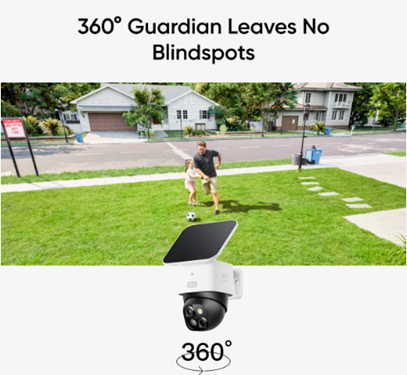Outdoor Camera Night Vision: Tech Explained
Outdoor cameras are essential for home security, especially at night. Night vision technology significantly enhances the capability of these devices. Understanding different night vision technologies can help consumers make informed decisions about which camera best suits their needs. As security threats increase, so does the sophistication of surveillance equipment. This guide will explore the main types of night vision technologies in outdoor cameras, including infrared, starlight, and color night vision. We’ll also look at advanced modes that improve visibility in darkness. Moreover, we’ll dive into eufy’s contributions to this technology, showcasing how their products utilize these advancements to ensure high-quality images even in low-light conditions. Learn what key technical specifications to consider when comparing cameras, so you can select the best one for nighttime security.
Basics of Night Vision in Outdoor Cameras
Infrared (IR) Night Vision – How It Works
Infrared night vision is a staple in most security cameras. It uses infrared LED lights to illuminate an area that is invisible to the naked eye but can be captured by the camera sensor. These LEDs emit infrared light, which reflects off objects and returns to the camera lens, creating an image in varying shades of black and white. This technology is highly effective and cost-efficient, making it perfect for standard use cases. However, it can sometimes produce grainy images under extreme darkness or through obstructions like fog or glass. IR technology’s main advantage is its ability to provide illumination without alerting potential intruders.
Starlight and Low Light Sensors
Starlight technology represents a leap in night vision capabilities, enabling cameras to produce color images even in low-light conditions. Unlike infrared, starlight sensors rely on the ambient light from stars or moonlight. They utilize a larger sensor, wide aperture lens, and advanced imaging processors to capture details in near darkness. This allows for brighter and clearer images compared to infrared. Starlight sensors eliminate the need for additional lighting which can draw attention, making it ideal for discreet surveillance. This technology maintains color accuracy, providing more context in footage for precise threat assessment.
Advanced Night Vision Modes
Color Night Vision with Spotlights
Color night vision equipped with spotlights is an innovation that fills the gap left by traditional infrared systems. When motion is detected, a built-in spotlight turns on to illuminate the scene. This allows the camera to capture full-color video regardless of external lighting conditions. The spotlight can also serve as a deterrent to potential intruders by drawing attention to suspicious activity. Additionally, color night vision aids in capturing specific details like clothing color or enablers on a vehicle, which are crucial in investigations.
MaxColor, Adaptive Spotlight & Hybrid Modes
MaxColor vision and adaptive spotlight technologies represent the next evolution of night vision. They adapt to environmental changes by automatically adjusting the intensity of the light and camera settings for optimal imaging. Hybrid modes combine infrared and color night vision. Under normal low-light conditions, the camera captures using color vision, but switches to infrared when it is too dark, thus ensuring clarity. These advancements provide flexibility, combining discretion and visibility, thereby ensuring comprehensive surveillance coverage.

Key Technical Specs to Compare
IR LED Wavelength, Number & Power
The wavelength, number, and power of IR LEDs are crucial. A shorter wavelength (around 850nm) offers better range but may produce a red glow. More LEDs enhance illumination, while power determines the intensity of light emitted, affecting image clarity.
Sensor Size, Aperture & Noise Reduction
A larger sensor captures more light, improving image quality in low-light scenarios. A wider aperture allows more light into the lens, leading to brighter images. Effective noise reduction technology minimizes image grain, enhancing clarity.
Night Vision Range & Field of View
The night vision range defines how far the camera can capture clear images in darkness. A wider field of view means more area coverage, reducing blind spots and ensuring comprehensive monitoring.
How eufy Outdoor Cameras Use Night Vision Tech
eufyCam S3 Pro & MaxColor Vision
The eufyCam S3 Pro integrates MaxColor vision, offering vibrant color imaging even at night. Its advanced sensor and adaptive lighting make it one of the most effective night vision cameras available, ensuring critical details are captured clearly.
eufy Outdoor Cam Spotlight & Night Modes
eufy’s outdoor cameras feature spotlight-enhanced night modes. This setup not only deters intruders but also enhances video quality. The adaptive spotlight automatically adjusts its intensity based on detected movement, ensuring optimal visibility.
Conclusion
Choosing an outdoor camera equipped with advanced night vision technology is vital for effective home security. Understanding the differences between infrared, starlight, and color modes can guide you in selecting the right device. eufy’s innovative use of these technologies in their cameras ensures users receive high-quality, reliable imaging, crucial for monitoring and protecting property at night. By assessing key technical specifications, consumers can pick the camera that best meets their security needs.
Search Blog
Category
Hot Articles
-
Popular Company Party Prize Ideas
-
5 Best Practices for Tablet Maintenance and Care
-
How to Charge Your Laptop without a Charger
-
Unleashing the power of innovation: HONOR 70
-
A Guide to the Best Headphones for 2022
-
The Importance of Labels for Supvan: Six Reasons You Need Them
-
It's Time to Install a Solar Panel Generator
-
Understanding the New Innovative Launch of Honor in 2023
